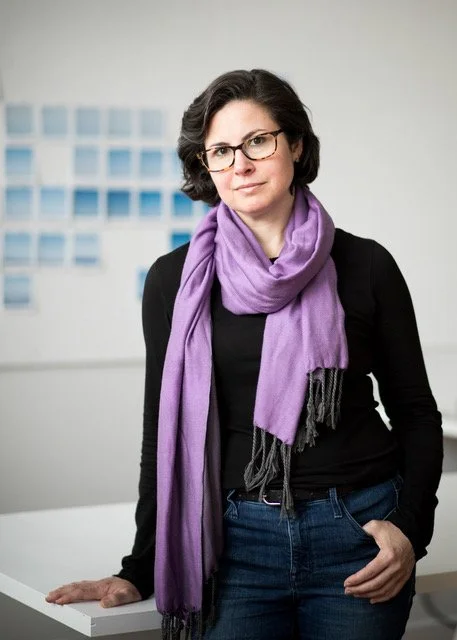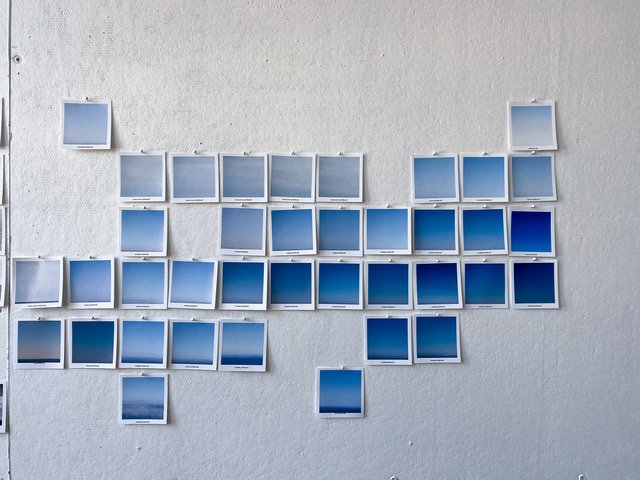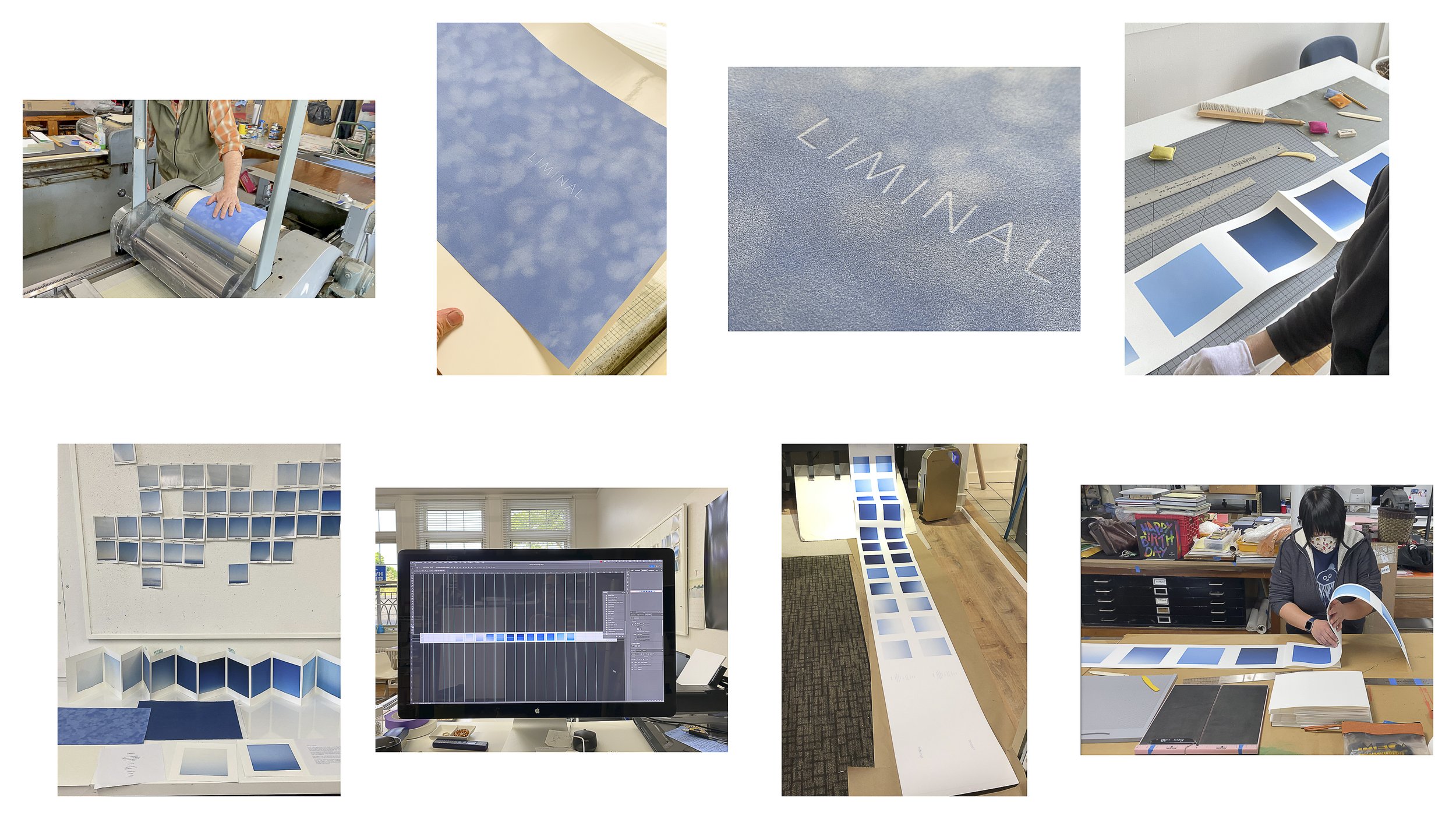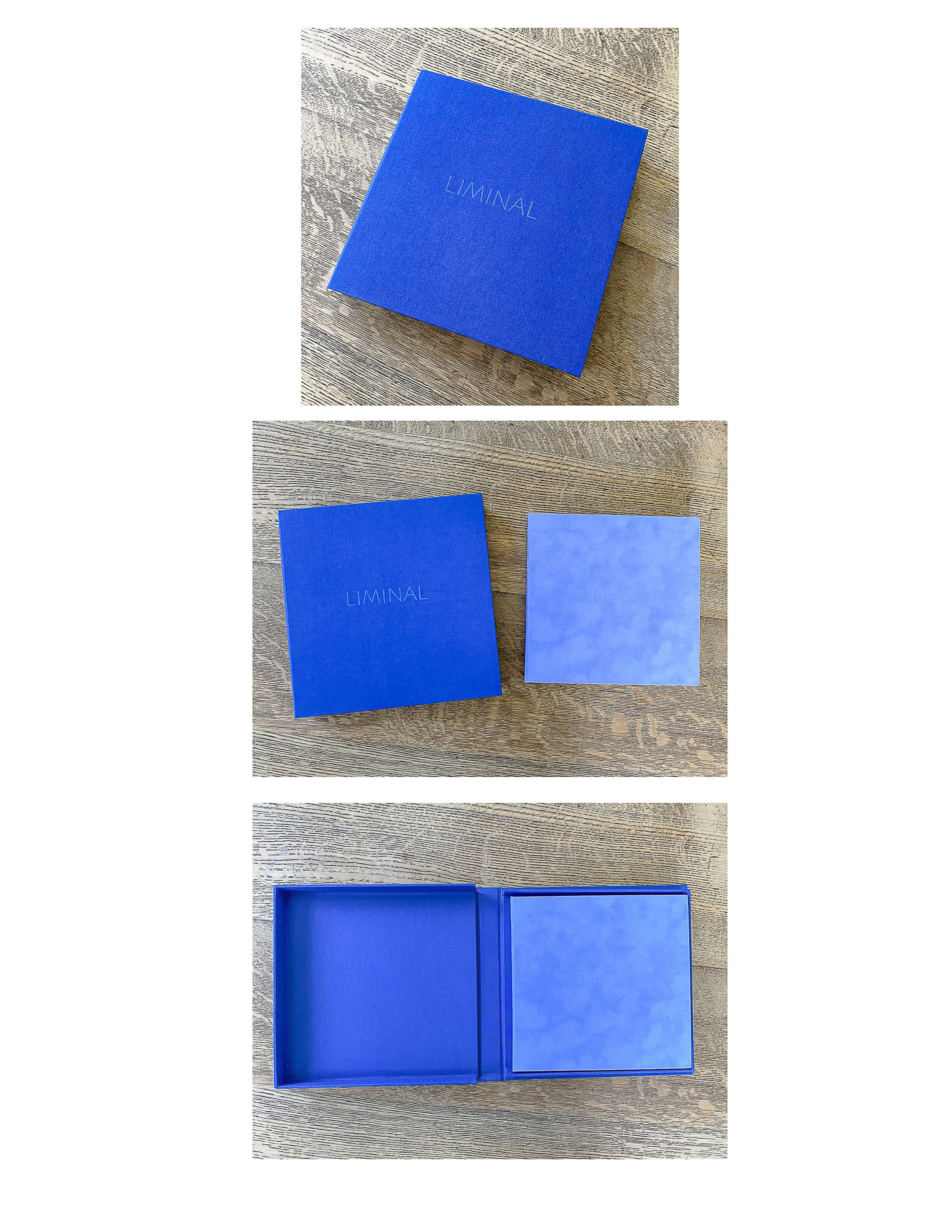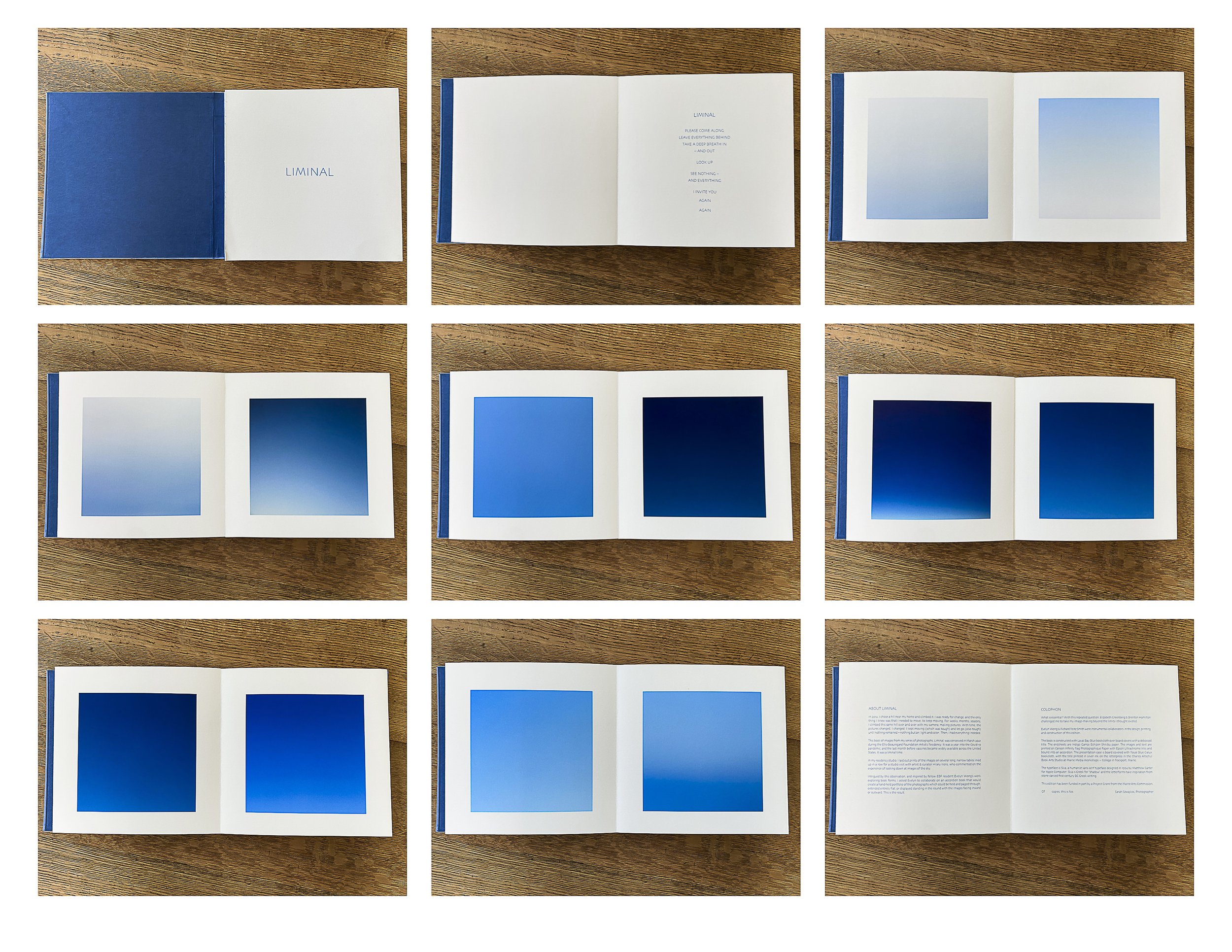Sarah Szwajkos, About the Liminal series
Sarah Szwajkos in her studio in Rockland, Maine
The images in my series Liminal may at first appear to be simple squares of various blue hues. Upon closer inspection, they reveal depths of subtle gradation. Whether captured or created, these images often inspire curiosity or questions. They are the results of walking meditations with with my camera. Shared as glowing sculptural squares on a wall, and rich pages in a special book, they are an invitation to pause and reflect on both what surrounds us and fills us.
Sarah Szwajkos
Sarah Szwajkos, Liminal lll, lV and Xl, Archival pIgment print face mounted to plexi, 1/5, 2015, 30 x 30 inches. $3000.
An installation of the series and the book at the Morphing Medium exhibition at MMPA.
Sarah Szwajkos’s practice involves climbing to a high vantage point and photographing open sky. She then mounts these large-scale prints onto Plexiglas. That is a fairly conventional use of the medium. Yet there is no indication of the source material here, which is intentional. We are simply confronted by what look like color studies. The Plexi allows light to seep into the area behind the prints themselves, making them feel liquid and glowing.
The combined effect of this technique and practice allows Szwajkos to conjure a different state of mind and space entirely, something that exists, in the words of her statement (actually a poem she wrote) “in between – everything and nothing.” Rather than simply capturing a specific moment in time with its particular conditions (photography’s earliest aim), it transports us to a non-existential mystical state.
- Jorge Arango writer for the Portland Press Herald
Sarah Szwajkos, Liminal lV, Archival pIgment print face mounted to plexiglass, 1/5, 2015, 30 x 30 inches, $3000.
Liminal
I am happiest when I am singing.
When I meditate, I chant.
Singing, chanting – my brain quiets down.
My joy rises.
Making these pictures, something similar happens to me:
I get out of my mind.
I go into my senses.
I connect with my intuition.
I don't think; I respond.
The world hums.
I vibrate.
The pictures sing.
We exist somewhere in between – everything and nothing.
Some process images and the works installed in the current MMPA exhibition, The Morphing Medium.
JAN PIETER VAN VOORST VAN BEEST INTERVIEWS SARAH SZWAJKOS
Sarah Szwajkos is a fine art and commercial photographer living and working in Midcoast Maine whose work has been exhibited and published nationally. Her recent personal projects stem from her ongoing search for mental health and equanimity, and use photography to explore and transform the everyday into something extraordinary – something that can put the photographer and viewers into contact with the transcendent.
J.P: Did the work from your series “Liminal”, that is going to be shown at MMPA this fall have its origins in the previous series of landscapes that were taken at Beech Hill?
Sarah: The images in the Liminal series are indeed the culmination of the project that began as a weekly commitment to visit Beech Hill in Rockport, making photographs in the landscape while climbing up and down the farm road to the ocean lookout at the summit. After several busy years immersed in growing my commercial photography business photographing interiors and architecture, this project began as a search to foster connection with nature and with personal image-making. I was at a point where my work for clients kept me busy enough that I could let go of other employment. This opened up space and time in both my schedule and my psyche for an important question which was following me like a shadow: If I wasn’t making images for an assignment, what images would I make? It was a time of clearing the decks, of making physical and emotional space…. I watched Beech Hill transform from the abundant greenery of late summer into the fading, flattening fall, and then the stark scenery of winter. Through months of cold, short days I walked up and down, seeking simplicity, thinking about compressing three dimensions into two, watching birds and clouds occupy the space between the ground beneath me and whatever is up above and beyond. Even when I started venturing with my camera to landscapes further afield, my preoccupations remained with paring things down – both the content of the images and the content of my thoughts – to only what is essential. In the end, all that remained in the images was the clear blue sky, with its infinite gradations of color, with its space, with its possibilities.
J.P: “Liminal” is an interesting title for the series. The term signifies a place in between and may refer to the ambiguity that occurs in that space. So where would you go with a follow up project and would it be related?
Sarah: I learned the word “liminal” while studying the work of Twentieth century Italian poet Eugenio Montale at the University of Florence during my junior year of college. I think the word and its nuances stuck with me because it resonated with where I was when it entered my vocabulary: very much on a threshold, straddling two countries, cultures, periods of life…. I think of it as meaning “in between”, but it’s such a poetic way to describe a place or time or state of change, transition, not quite here nor there, not quite this or that. It’s what’s happening inside the chrysalis when the caterpillar is turning into the butterfly. It’s the sky, the domain of birds, those symbols of spirituality that connect earth with the heavens. That year when I was photographing the landscape, the horizon, the sky – it turned out to be a very transitional year bridging two quite distinct periods of my life. The end of my artist statement about the Liminal series says that these are images of everything and nothing. In one sense, I was clearing out all the clutter to make way for possibility. And once I’d done that, lots of change came. The next few years were busy in other ways; and when I once again turned my focus, my time and energy, to personal work, it’s like the roof blew off. And not even the sky was the limit anymore! I’m someone who is drawn to symmetry and balance; I work daily within the parameters of architectural photography, whose first commandment is that vertical lines must be straight and parallel. It’s challenging to describe without showing you the photographs that have come since, in the bodies of work Phenomena, Mis/Alignment and Breathtaking. If Liminal was about the space in between, making room, opening up, then the work since has been about breaking all the so-called rules of photography: shooting into the light, leaving the shutter open, moving the camera around during exposure, taking light and chance as my subjects. Being challenged to let go of my assumptions and to push boundaries – that’s what made it possible for the landscapes of Between Heaven & Earth to become Pre-Liminal and then the pure gradients of Liminal. I have no doubt that the Liminal series represents a turning point in my work as an artist, and that the images I have made since would not have been possible if I hadn’t followed my intuition to take my camera, go outside, and walk uphill, over and over again.
J.P: I remember that we had one photograph of the “Liminal” series at the MMPA “Collectors” exhibit a few years ago. It was a striking piece, even by itself. Now you made a book of the series and it should be fascinating to see the work in this context and the narrative that is created by serializing the work. When you started this series did you start it with a single piece or did you have a series in mind from the beginning?
Sarah: As the Liminal images began to emerge from the landscape photographs, I was sharing them in a critique group, taking my turn each week to put my images up among a group of colleagues, tacking them to the walls of the room where we met. It became clear very quickly that the energy that pulsed from the individual images magnified as I hung more up so they surrounded us on two, three, four walls. So, very early on, I began to envision the series as an installation, a chapel if you will, creating a space for contemplation or meditation. The three large pieces on display now at MMPA are part of the larger group of a dozen or more images from the Liminal series that ultimately I would like to install together to create a space of quiet and respite.
J.P: To me, the “Liminal” series could be about photographs of the sky. Would you mind telling us about your process? Did you start with a photograph in camera or are the images a Photoshop process from the start?
Sarah: All of the images in the Liminal series are digital captures made in the landscape, pointing my DSLR at the sky. Lightroom and Photoshop are the tools of my digital darkroom, along with the inkjet printer and papers in my studio. There is not a lot of complex Photoshop going on here, I promise! The biggest technical challenge was figuring out how to mitigate the digital noise and keep the gradients smooth as the prints got larger. For such seemingly simple images, they are quite unforgiving, as any interruption in the smooth transitions jumps out and draws attention to itself. There are definitely personal aesthetic choices made in the processing and printing, but those are the kinds of color decisions I test and make when printing any body of work in the digital darkroom. So, these are actually pretty “straight” photographs. As I contemplated sharing the Liminal images, the object became my primary concern, as I realized I did not want to offer viewers a traditional photographic print on paper, and definitely not mitigated by a mat, glass, and frame. I felt that the pieces needed to be integrated: the image and the object needed to be one and the same. I landed on the presentation you see here, with an archival pigment print face-mounted to thick Plexiglas, thus transforming the two-dimensional print on paper into a three-dimensional object, a sculptural work that has heft and depth and presence. The half-inch depth of the Plexiglas, with its polished edges, draws in light and illuminates each image, creating a doorway, a threshold I’m inviting you to cross and enter into. Imagine finding yourself surrounded by these portals that seem to glow, that you can feel pulsing – that you can dive into, get lost in, curl up in, melt in, and emerge from, transformed somehow – you, but changed by having some time and space you may not have even realized would be helpful. That’s what I hope these images offer.
J.P: You have published a limited edition handmade artist’s book of the “Liminal” series. Could you tell us about the project and the process?
Sarah: Creating the Liminal installation is a process involving fundraising to produce the large works, as well as identifying and securing venues where the installation can be realized and be accessible. As I continued exploring possibilities for such an installation, I was fortunate to have a month-long artist residency through the Ellis-Beauregard Foundation, where I met artist Evelyn Wong. Her work in handmade book forms reminded me of my interest in bookmaking, and inspired me to invite Evelyn to collaborate on a limited-edition accordion-fold artist’s book of twelve images from the Liminal series. I received an artist’s project grant from the Maine Arts Commission which provided initial funding for the edition. While viewing the Liminal prints laid flat on tables during a studio visit, artist and curator Hilary Irons commented on the experience of looking down at images of the sky. This comment, in part, inspired the accordion book format that Evelyn and I designed, with additional collaboration from Richard Reitz Smith as the project evolved. The accordion of images (prefaced by a title page and poem and followed by a colophon) is over twelve feet long before folded and bound into a hard cover at only the back. This allows the book to be experienced in several formats: held in one’s hands, the pages can be turned as if reading a book, viewing two images at a time; or extended and laid out flat on a long table or bench to show all twelve images in a row. In addition, the accordion can be displayed upright (the hard cover and thick paper helping it stand) with the pages in a circle or star shape, facing in towards each other (and perhaps surrounding the viewer) or facing outward so the viewer might circumambulate the images, as in certain devotional practices. The materials were selected to elevate the experience of handling the book to create another kind of portal, one that invites the reader or viewer to cross a threshold into a space that is outside the quotidien – like a book of hours or a private chapel – inviting contemplation. The text and images are printed in the manner of my archival inkjet exhibition prints on a matte surface fine art paper. The book’s cover is a pale blue book cloth with light mottling (perhaps evoking clouds) and a velvet-like texture that brings the sensation of touch to the forefront. The cover was blind-stamped on the letterpress so that the title reveals itself through light and shadow. A clamshell box covered in dark blue cloth with the title printed on the letterpress with silver ink, evoking stars emerging from the night sky, surrounds and protects the book inside. One of my intentions for an installation of the Liminal work is to offer an opportunity for quiet contemplation in a public space that could be accessible to anyone who passes by. An artist’s book might be a bit of a precious, rarified object, accessible to only a few. The act of making a book by hand necessitates a meditative process. Through both the making and the sharing of this book, I offer opportunities for slowing down and focusing on the present moment, in between whatever came before and whatever comes next. It is my aim to place the copies in this edition into collections where handmade books are preserved and shared; that this book might reach more people through those collections; and that perhaps the handmade edition will provide inspiration for a trade edition that would be less precious, but more accessible. What I’m learning through this process is that I am willing to adapt my materials in order to disseminate the work and share the experience and the message.

